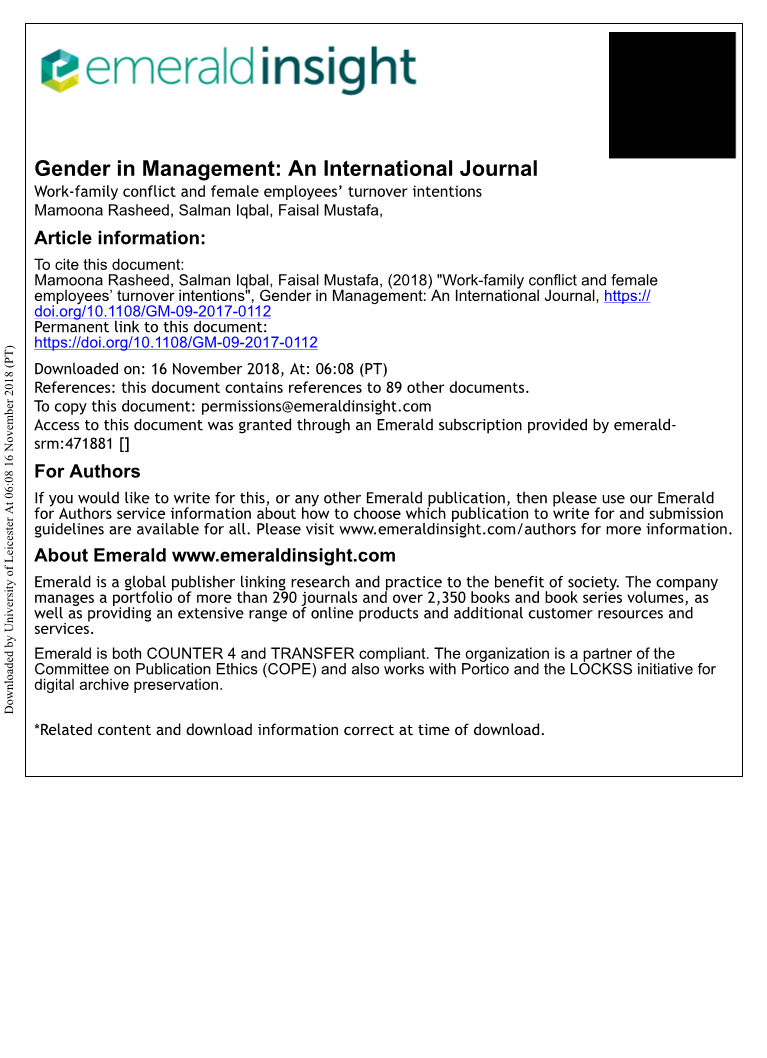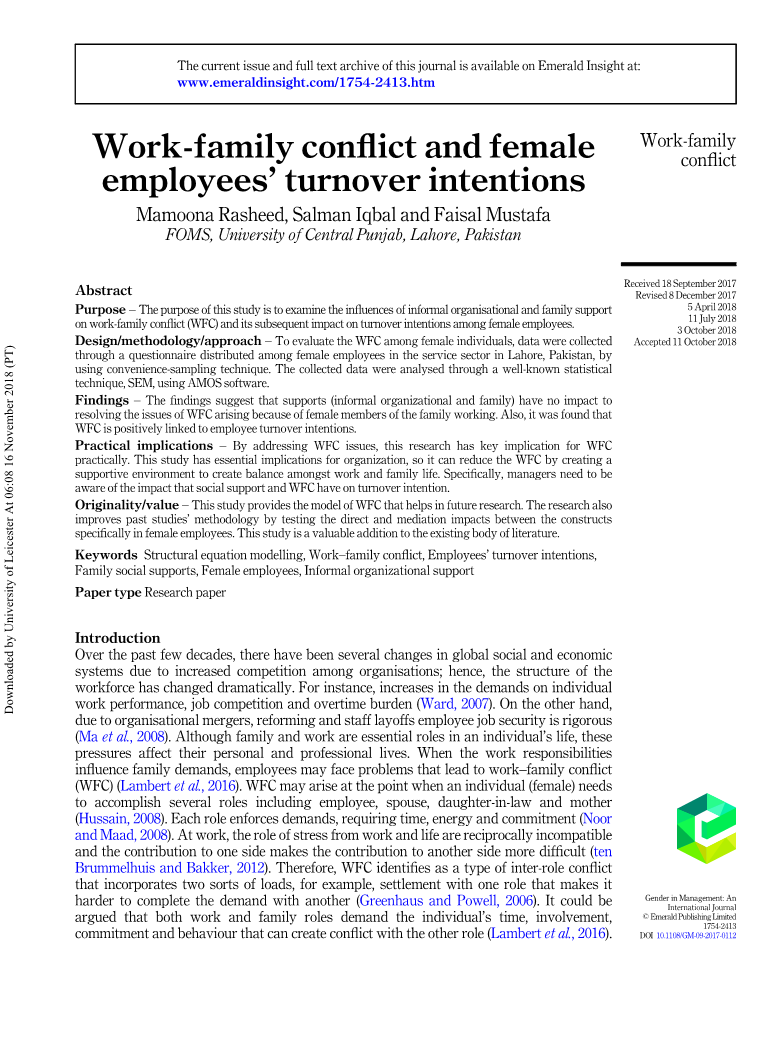

英语原文共 19 页,剩余内容已隐藏,支付完成后下载完整资料
外文原文
Work-family conflict and female employeesrsquo; turnover intentions
Mamoona Rasheed, Salman Iqbal and Faisal Mustafa FOMS, University of Central Punjab, Lahore, Pakistan
Abstract
Purpose – The purpose of this study is to examine the influences of informal organisational and family support
on work-family conflict (WFC) and its subsequent impact on turnover intentions among female employees.
Design/methodology/approach – To evaluate the WFC among female individuals, data were collected through a questionnaire distributed among female employees in the service sector in Lahore, Pakistan, by using convenience-sampling technique. The collected data were analysed through a well-known statistical technique, SEM, using AMOS software.
Findings – The findings suggest that supports (informal organizational and family) have no impact to resolving the issues of WFC arising because of female members of the family working. Also, it was found that WFC is positively linked to employee turnover intentions.
Practical implications – By addressing WFC issues, this research has key implication for WFC practically. This study has essential implications for organization, so it can reduce the WFC by creating a supportive environment to create balance amongst work and family life. Specifically, managers need to be aware of the impact that social support and WFC have on turnover intention.
Originality/value – This study provides the model of WFC that helps in future research. The research also improves past studiesrsquo; methodology by testing the direct and mediation impacts between the constructs specifically in female employees. This study is a valuable addition to the existing body of literature.
Keywords Structuralequationmodelling,Work–familyconflict,Employeesrsquo;turnoverintentions, Family social supports, Female employees, Informal organizational support
Paper type Research paper
Introduction
Over the past few decades, there have been several changes in global social and economic systems due to increased competition among organisations; hence, the structure of the workforce has changed dramatically. For instance, increases in the demands on individual work performance, job competition and overtime burden (Ward, 2007). On the other hand, due to organisational mergers, reforming and staff layoffs employee job security is rigorous (Ma et al., 2008). Although family and work are essential roles in an individualrsquo;s life, these pressures affect their personal and professional lives. When the work responsibilities influence family demands, employees may face problems that lead to work–family conflict (WFC) (Lambert et al., 2016). WFC may arise at the point when an individual (female) needs to accomplish several roles including employee, spouse, daughter-in-law and mother (Hussain, 2008). Each role enforces demands, requiring time, energy and commitment (Noor and Maad, 2008). At work, the role of stress from work and life are reciprocally incompatible and the contribution to one side makes the contribution to another side more difficult (ten Brummelhuis and Bakker, 2012). Therefore, WFC identifies as a type of inter-role conflict that incorporates two sorts of loads, for example, settlement with one role that makes it harder to complete the demand with another (Greenhaus and Powell, 2006). It could be argued that both work and family roles demand the individualrsquo;s time, involvement, commitment and behaviour that can create conflict with the other role (Lambert et al., 2016).
Now, in Asia, particularly in the subcontinent, women support men through entering the workforce to meet economic and social needs.
The increasing trend of dual-earners includes men and women demanding to share responsibilities that may affect the family life (Ward, 2007). Particularly for women, it is difficult to balance the work burdens due to family responsibilities (Faiz, 2015). Moreover, as female employees may face more problems both at work and family, increased demands at work may influence the responsibilities of the family (Lambert et al., 2017). Therefore, turnover rates among female employees is higher at work, and organisations are facing replacement costs. The cost of replacing an employee is equivalent to the annual salary of an employee (Altman, 2017). The replacement cost also includes indirect costs like loss of social networks, expertise, personnel shortages, reduced services and overworked remaining staff. This study will focus on WFC and turnover intention.
The existing literature on work and the family mostly emphasises the formal workplace supports such as work–family policies, flexible working hours and childcare centres on how work may help reduced WFC (Kossek et al., 2011). Nevertheless, researchers have concentrated on informal organisational support that includes supervisors and co-workers sympathetic to WFC (Aminah and Zoharah, 2012). Owing to the dearth of knowledge, this study focuses on social support and its association with WFC. Social support, known as social interaction, contributes people to actually support and have feelings of attachments to an individual or union that is seemed as loving and caring (Lambert et al., 2017). Social support plays an essential role while exploring the interaction between family and work (Erickson et al., 2010). It also includes emotional and practical support received from family and spouse (Matsui et al., 1995). This study focused on social exchange theory (SET) to explain the linkages between WFC and social support (ten Brummelhuis and Bakker, 2012). SET defines that individuals enter into connections with others to maximise their benefits and reduce costs (Blau, 1964; Greenhaus and Beutell, 1985). The previous studies on thes
剩余内容已隐藏,支付完成后下载完整资料
资料编号:[589012],资料为PDF文档或Word文档,PDF文档可免费转换为Word


